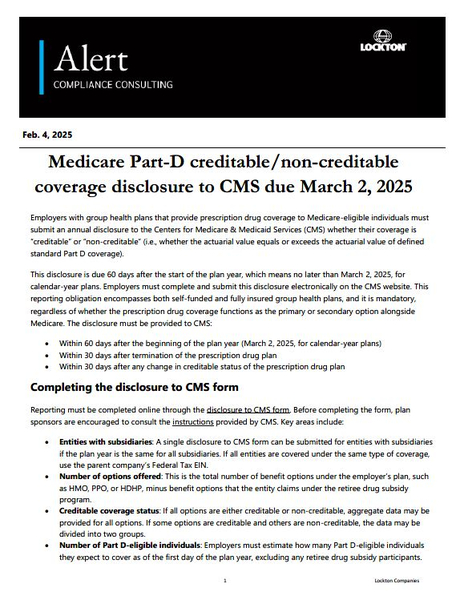Employers with group health plans that provide prescription drug coverage to Medicare-eligible individuals must submit an annual disclosure to the Centers for Medicare & Medicaid Services (CMS) whether their coverage is “creditable” or “non-creditable” (i.e., whether the actuarial value equals or exceeds the actuarial value of defined standard Part D coverage).
This disclosure is due 60 days after the start of the plan year, which means no later than March 2, 2025, for calendar-year plans. Employers must complete and submit this disclosure electronically on the CMS website. This reporting obligation encompasses both self-funded and fully insured group health plans, and it is mandatory, regardless of whether the prescription drug coverage functions as the primary or secondary option alongside Medicare. The disclosure must be provided to CMS:
Within 60 days after the beginning of the plan year (March 2, 2025, for calendar-year plans)
Within 30 days after termination of the prescription drug plan
Within 30 days after any change in creditable status of the prescription drug plan
Completing the disclosure to CMS form
Reporting must be completed online through the disclosure to CMS form (opens a new window). Before completing the form, plan sponsors are encouraged to consult the instructions (opens a new window) provided by CMS. Key areas include:
Entities with subsidiaries: A single disclosure to CMS form can be submitted for entities with subsidiaries if the plan year is the same for all subsidiaries. If all entities are covered under the same type of coverage, use the parent company’s Federal Tax EIN.
Number of options offered: This is the total number of benefit options under the employer’s plan, such as HMO, PPO, or HDHP, minus benefit options that the entity claims under the retiree drug subsidy program.
Creditable coverage status: If all options are either creditable or non-creditable, aggregate data may be provided for all options. If some options are creditable and others are non-creditable, the data may be divided into two groups.
Number of Part D-eligible individuals: Employers must estimate how many Part D-eligible individuals they expect to cover as of the first day of the plan year, excluding any retiree drug subsidy participants. This includes active employees, retirees, disabled individuals, dependents, or individuals on COBRA (Carriers, TPAs and PBMs may be able to assist with the estimate).
Disclosure to plan participants
Part of the CMS reporting is to provide the date on which the plan sponsor distributed the Medicare Part D Creditable or Non-Creditable Notice to Medicare-eligible individuals. This requirement extends to Medicare beneficiaries who are both active employees and retirees, as well as those Medicare beneficiaries covered as spouses and dependent children under either active or retiree coverage. The purpose of this disclosure requirement is to inform plan participants that they will have to pay a higher Part D premium if they do not enroll in Part D when first eligible, unless they have creditable coverage through another plan and enroll in Part D within 63 days of losing the creditable coverage. The disclosure to plan participants is required at the following times:
Prior to the annual Part D enrollment window, which opens each Oct. 15
Prior to the individual’s personal initial enrollment period (IEP) for Part D
Prior to enrollment in the employer’s plan
Whenever the plan ceases to provide drug coverage or the creditable nature of the coverage changes
Upon request by the Medicare-eligible individual
Lockton comment: For the first and second bullets above, a plan only needs to provide the notice once every 12 months. Lockton recommends including the creditable or non-creditable notice in the employee annual open enrollment benefit packet and new hire benefit packet. Doing so takes care of the first three bullet points above. Because most plans don’t know who their Medicare-eligible members are, especially regarding dependents, distributing the notices to all enrolling and enrolled employees and retirees is highly recommended.
Plans that are exempt from the filing process
Group medical plans that do not offer drug coverage to any Medicare-enrolled employee, retiree, or dependent at the beginning of the plan year are exempt from filing. Similarly, employers who qualified for the Medicare Part D retiree drug subsidy are exempt from filing with CMS. However, this exemption only applies to the individuals and plan options for which the subsidy was claimed. If an employer offers prescription drug coverage to any Medicare-enrolled retirees or dependents not claimed under the subsidy, the employer must complete an online disclosure for plan options covering such individuals.
Lockton comment: As the exemptions are limited, plan sponsors should complete the CMS filing to the best of their ability, even if they suspect, but are not sure, that their plan is exempt from filing.
Not legal advice: Nothing in this alert should be construed as legal advice. Lockton may not be considered your legal counsel, and communications with Lockton's Compliance Consulting group are not privileged under the attorney-client privilege.
For more alerts, insights and additional information, click here (opens a new window) to visit Lockton's ERISA Compliance Consulting page.
 Download alert (opens a new window)
Download alert (opens a new window)

